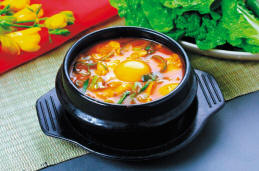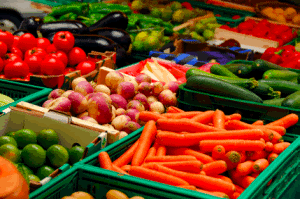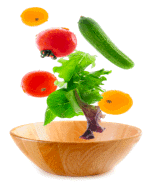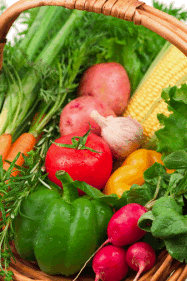Soup and
Salad!
Kimberly Tubbs
Beginning to Low-Intermediate ESL Adult Learners

Introduction | Task | The Process | Evaluation | Conclusion | Resources |Credits| Handouts| Teacher Notes
In this project, you will learn about terms for cooking and eating, and tell stories about a special recipe for soup. As a class, we will eat this soup along with family members we invite. Ask for help when you need it!
The Task- Learn terms found in cook books including vegetables, cooking ingredients and cooking methods.
- Tell stories about a recipe/foods through pictures or words.
- Find cookbooks in the library and study how to lay out a cookbook
- As a group, work together to produce a cook book with stories.
- Complete a picture story about making a soup or salad.
- Identify pictures of vegetables and other ingredients by matching pictures to words, and by visiting the grocery store.
- Bring to class a recipe for soup or salad that you have a story about. This may involve going to the library, looking on the web, or bringing in your favorite recipe that you have translated to English. Then tell the story about the recipe by drawing pictures, cutting out pictures, or orally telling the story.
- Go to the library to review how they lay out cook books.
- Come together as a group to produce a cook book with each recipe and story about the recipe.
- Make the soup or salad at home, and bring it to class to share with classmates, invited family members, and friends.
- For advanced classes follow the advanced options!!
|
Beginning 1 |
Developing 2 |
Accomplished 3 |
Exemplary 4 |
Score |
|
|
Complete a picture story about making soup
|
Students attempt the exercise but do not put pictures in order. |
Students are able to put a few of the pictures in order. |
Students are able to put most of the pictures in order. |
Students are able to put all pictures in the correct order. |
|
|
Identify pictures of fruit, vegetables, and other ingredients through the game memory, through matching pictures to words, and through a trip to the grocery store
|
Students can identify at least two items needed to make soup or salad. They may not be able to find the items in a store but they at least participate in the trip to the grocery store. |
Students can identify at least five total items needed to make soup or salad. Students can demonstrate their knowledge by finding these items in a grocery store. |
Students can identify at least three vegetables and three other ingredients for soup or salad. Students can demonstrate their knowledge by finding these items in a grocery store. |
Students can identify at least five vegetables and five other ingredients for soup or salad. Students can demonstrate their knowledge by finding these items in a grocery store. |
|
|
Have the students and yourself bring a recipe for soup that you have a story about. This may involve going to the library, looking on the web, or bringing in your favorite recipe that you have translated to English. Then, they tell the story about the recipe by writing, drawing pictures or cutting out pictures, and orally telling the story. |
Students bring in a recipe. |
Students bring in a recipe and tell a story by at least one way. |
Students bring in a recipe and tell a story by at least two out of three ways. |
Students bring in a recipe, and tell a story by writing, drawing pictures or cutting out pictures and orally telling the story. |
|
|
Go to the library to review how they lay out cook books. Come together as a group to produce a cook book with each recipe and story about the recipe |
Students go to the library and review at least one cook book. |
Students go to the library and review at least one cook book sharing their opinions about what they like and dislike about the cook books. |
Students go to the library and review at least two cook books sharing their opinions about what they like and dislike about the cook books and participate in deciding how the class cook book should be formed. |
Students go to the library and review at least three cook books sharing their opinions about what they like and dislike about the cook books then they come together as a group and participate in deciding how the class cook book should be formed. |
|
|
Make the soup at home, and bring it to class to share with class mates, invited family members, and friends, and talk about the process of making the soup. |
Students talk with their classmates during sharing time. |
Students make soup at home and bring it to class to share. |
Students make soup at home, bring it to class to share, invite friends and family |
Students make soup at home, bring it to class to share, invite friends and family, and talk about the process of making soup or salad |
Food is something each one needs and therefore is something we have in common. This class entitled Making Soup, is a fun way to get to know your classmates, learn about food vocabulary, and tell stories. It can lead to deeper learning through this advanced option.
Advanced Options
- Access the community to determine possible causes to donate to by cooking a Community soup dinner
- Use the phone book and maps to find community agencies.
- Talk with community members about the project.Organizing the soup dinner event as a class coming to agreement on a cause/group.
- Find five recipes on the internet and journal about making them at home.
- Complete a word story about the soup or salad recipe.
- Learn measurements/math involved in cooking.
Resources (See handouts below.)
-
McGraw-Hillís Pre-GED, Gallagher et al.,2003, New York, NY
|
To make the class easier to begin with, I cut out many things. One of the things I cut out was the math portion. This would start with cutting out circles and end with using actual measuring cups. All the students need is the following:
|
|
Exercise 1
___________________________________________________________________
___________________________________________________________________ |
Exercise 2

Draw lines to match the words with items in the picture.
CARROT TURNIP TOMATO
ZUCCHINI LIME PEPPER
EGGPLANT POTATO
Which are items are actually fruits?
__________________________________________________________
| Exercise 3
Draw lines to match the items on the face with the words provided. Put a yes or no beside words to indicate if they would go well in soup. For extra credit write F next to the fruits and V next to the vegetables. ITEMS TOMATILLO PARSNIP APPLE POTATO GREEN BEANS
JALAPE—O PEPPER LETTUCE NECTARINE OLIVES
BANANA PEPPER PARSLEY Draw a picture or cut out a picture of the items you plan to put into your soup and then label them by name. For extra credit name the fruits.
|
|
Exercise 4
Work with a partner. Name all the items in this basket and tell a story a story about how you would each one.
|
|
Exercise 5
____________________________________________________________
____________________________________________________________ ___________________________________________________________ ___________________________________________________________ ___________________________________________________________ ___________________________________________________________
|




